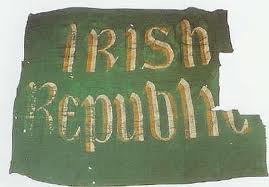Book Review: The Story of the Easter Rising, 1916
 Cathal Brennan reviews the first in the Irish Story’s Story of series, The Story of the Easter Rising, 1916 by John Dorney.
Cathal Brennan reviews the first in the Irish Story’s Story of series, The Story of the Easter Rising, 1916 by John Dorney.
The Story of the Easter Rising, 1916 by John Dorney, Green Lamp Media, 2009.
(Follow The Link To Purchse)
Reviewer: Cathal Brennan
With the 100th anniversary of the Easter Rising less than five years away hopefully we can look forward to a huge increase in books and articles on the rebellion, to match a renewed interest that the commemoration will bring. In that vein, John Dorney’s The Story of the Easter Rising, 1916 (first in The Story of series) is a welcome addition.
Published by Green Lamp as a downloadable PDF and also in Kindle and in hard copy on request; at 68 pages it is an easily digestible summary of the events of Easter Week 1916. The short book is split into seven parts and takes the reader through the political situation in Ireland leading up to the Rising, the structure of government, the crisis over Home Rule, the planning of the Rising, a description of the organisations and individuals involved, the Rising itself and its aftermath.
Dorney takes the reader through the situation leading up to the Rising, The Rising itself and its aftermath
Many works have dealt with the effect that the Rising had on radicalising Irish nationalism and too often it is dealt with briefly before moving on to the rise of Sinn Féin and the War of Independence. This is a shame as the events of Easter Week are a fascinating combination of heroism, idealism, appalling bad luck and, at times, incredible incompetence.
The military plans for the Rising were audacious and hopelessly unrealistic. The strength of the Irish Volunteers at the time was just over 13,000 men and the aim was that they could all be armed by German rifles that were due to arrive on the Aud.
Strategic centres were to be occupied by the rebels in Dublin, Cork and Limerick. Ulster was to be abandoned as a scene of fighting while Volunteers from the west of the province were to assemble at Cookstown, County Tyrone before marching south to connect with Liam Mellows’ forces coming from Galway. They would then ‘hold the line of the Shannon.’
The military plans for the Rising were audacious and hopelessly unrealistic
Volunteers from east Ulster and Louth would converge on Tara in County Meath before meeting up with the men under Thomas Ashe and Richard Mulcahy in north county Dublin, where, along with vounteers from Wexford, they could supply reinforcements to the insurgents in Dublin City.
As the British would slowly get the upper hand in Dublin they would retreat to the Shannon and then fall back to make a final stand for the Republic in County Sligo.
With the capture of Roger Casement, and the failure of the Kerry Volunteers to obtain the German arms, whatever thin hope existed that the military plan would work rapidly evaporated.
Despite the countermanding order by the Chief of Staff, Eoin MacNeill, the conspirators decided to press ahead with their plans on Easter Monday.

In 1962 Major D.J. Goodspeed of the Canadian military published a book called The Conspirators in which he analysed the Rising from a purely military standpoint.
In it he dealt with several errors the rebels made that he judged as unforgivable from a strategic point of view.
He lists the failure to disrupt the communications system in the city, the failure to secure Kingsbridge (Heuston) and Amiens Street (Connolly) train stations, which were vital to the British for bringing reinforcements in from the Curragh and Belfast, and the inexplicable decision to dig trenches in St. Stephen’s Green instead of occupying some of the high buildings surrounding it.
One of the sources that Dorney uses is Insurrection in Dublin by James Stephens. Stephens was the registrar of the National Gallery of Ireland and his book was a diary of the events of Easter Week as he made his way from his flat on Fitzwilliam Place to the Gallery each day.
Stephens travelled in the same literary circles as MacDonagh, Pearse, Plunkett and Sheehy–Skeffington and his insights and descriptions of the events and leaders of the Rising was not flavoured by the upsurge in patriotic feeling that surrounded 1916 in the following years as his work was published within months of the rebellion.
Dorney correctly takes issue with the assumption that British repression turned a population hostile to the actions of the rebels to one which respected their sacrifice.
This book has been been out of print for many years and hopefully we shall see a lot of the articles and memoirs written about this period re-released in time for the 100th anniversary.
Two works that should definitely be reprinted are F.X. Martin’s 1916 – Myth, Fact and Mystery (1967) and The 1916 Rising – a Coup d’État or a ‘Bloody Protest’? (1968), hopefully as part of a collection of other articles that were published around the time of the 50th anniversary.
In his conclusion Dorney correctly takes issue with the assumption that British repression after the Rising turned a population which was hostile to the actions of the rebels to one of sympathy and respect for their sacrifice. Despite the image of Dublin citizens, and particularly the ‘seperation women’, having to be restrained from physically attacking the Volunteers, there was also support for their actions among a lot of the people of Dublin.
The problem for the British government was that whatever policy they pursued after the Rising was going to be the wrong one
Dorney states that, ‘the (British) reaction to the Easter Rising was rather mild,’ and it is hard to argue with this assessment, especially considering the reaction of the French government to the Paris Commune in 1871, (where up to 20,000 insurgents were executed) as Dorney points out.
Given the fact that the UK was at war and the Volunteers had allied themselves with Britain’s enemies it is hardly surprising that the leaders were executed, but the internment of thousands of Republicans throughout the country, and the execution of people such as Willie Pearse, who seemed to be executed solely on the basis of being Patrick’s brother, did much to alienate nationalist Ireland.
Even among many constitutional nationalists there was a respect for the bravery of the insurgents and the fact that they could hold out against the British for almost a week. The problem for the British government was that whatever policy they pursued after the Rising was going to be the wrong one as large sections of the population had already lost all confidence in Westminster fairly addressing Irish national aspirations..
The Story of the Easter Rising should be consulted by anyone who needs a concise and satisfying synopsis of a compelling event in Irish history
Dorney states, ‘this piece will not try to argue for the acceptance of any one of the competing interpretations of the Rising. It will hope merely to tell its story,’ and this is what Dorney does sucessfully. For students who are new to the subject, and for those who wish to reacquaint themselves, this download is a very useful resource and should be consulted by anyone who needs a concise and satisfying synopsis of a compelling event in Irish history
The Story of the Easter Rising, 1916 is available as a PDF download from the The Irish Story website, priced at €3.99 or $6.99. You can read a sample of the book at Google Books.
See also our review of Fearghal McGarry’s book The Rising and his interview on it here.
 Cathal Brennan was born in Dublin in March 1979 and grew up in Ayrfield. He graduated from Dún Laoghaire Institute of Art, Design and Technology in 2000 having studied television and video production and then was elected to serve in the Student Union for the next two years. After working for the NEAR Media Co – Op he returned to college to study history in Trinity. He has just completed the third year of his course.
Cathal Brennan was born in Dublin in March 1979 and grew up in Ayrfield. He graduated from Dún Laoghaire Institute of Art, Design and Technology in 2000 having studied television and video production and then was elected to serve in the Student Union for the next two years. After working for the NEAR Media Co – Op he returned to college to study history in Trinity. He has just completed the third year of his course.